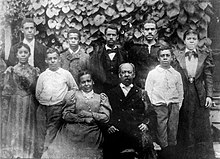William B. Gould I
William B. Gould (1837 – May 25, 1923) was a former slave and veteran of the American Civil War.

| Part of a series on |
| Dedham, Massachusetts |
|---|
 |
| History |
| People |
|
| Places |
| Organizations |
| Businesses |
| Education |
Early life
William B. Gould was born to a slave woman and perhaps an Englishman. He learned to read and write and is known for his detailed entries in a diary about his work as a plasterer. He was enslaved by the Nixon family and worked on the Bellamy House.[1]
On September 21, 1862, Gould escaped with seven other slaves by rowing a small boat 28 nautical miles (52 km) down the Cape Fear River and out into the Atlantic Ocean where the USS Cambridge of the Union blockade picked them up as contraband. Prior to the escape, Gould had been working as a plasterer at an antebellum mansion (now named the Bellamy Mansion) in Wilmington, North Carolina. At the time of his escape he appears to have been enslaved by Nicholas Nixon, a peanut planter and slave owner in Wilmington.
Naval service
After his escape, Gould joined the U.S. Navy and believed he was "defending the holiest of all causes, Liberty and Union."[2] Gould served on the USS Ohio, where he was rated a "boy."[3] While on board of the Ohio, he came down with the measles and have to leave the ship to go to the hospital.[3] Shortly before, he met John Robert Bond, another black sailor serving on the Ohio.[3] The two would reconnect ten years after the war and become good friends.[3]
Though black men served alongside white men in the Navy during the Civil War and made up roughly 15% of the Union Navy,[3] Gould experienced racism while serving onboard the USS Cambridge.[4] Black sailors were "treated shamefully," Gould said, when they were not allowed to eat out of mess pans and were called disparaging names.[4]
Diary
Beginning with his time on the Cambridge and continuing through his discharge at the end of the war he kept a diary of his day-to-day activities. According to John Hope Franklin, Gould's diary is one of three known diaries in existence written during the Civil War by former slaves. In the diary, Gould chronicles his trips to the northeastern United States, the Netherlands, Belgium, Spain, Portugal, and England.[5] The diary is distinguished not only by its details and eloquent tone, but also by its author's reflections on the conduct of the war, his own military engagements, race, race relations in the Navy, and what African Americans might expect after the war and during the Reconstruction Era.
Post-war life

After he was discharged from the Navy at the Charlestown Navy Yard in Massachusetts, he married Cornelia Read[2] in November 1865.[6] Cornelia was a former slave who was then living on Nantucket and they corresponded throughout the war. The Goulds moved to Milton Street in Dedham, Massachusetts, and together they had two daughters and six sons.[7] In Dedham, Gould "became a building contractor and community pillar."[8][7] The Gould home was close to the border with Readville, where former shipmate John Robert Bond settled after the war.[9][lower-alpha 1] Gould would later serve as godfather to Bond's second son.[10]
Gould "took great pride in his work" when he resumed work as a plasterer and helped to build the new St. Mary's Church.[2] One of his employees improperly mixed the plaster and even though it was not visible by looking at it, Gould insisted that it be removed and reapplied correctly.[2] He also worked as a stonemason, construcitng buildings around Dedham.[7][9] Gould and his family were more likely to experience subtle slights on account of their race as opposed to outright racism while living in Dedham.[11] He joined the Mt. Moriah Masonic Prince Hall Lodge in Cambridge with several other black veterans.[12]
Gould helped to build the Episcopal Church of the Good Shepard in Oakdale Square, though as a parishioner and not as a contractor.[7] It may have been the Episcopal church he attended in Wilmington as a slave that taught him to read and write, and thus to be able to keep his diary.[2] Gould's family remained active members of the church and, along with the Bonds and one other family, the Chesnuts, were the only black parishioners.[13]

Gould was extremely active in the Charles W. Carroll Post 144 of the Grand Army of the Republic (GAR).[14] He "held virtually every position that it was possible to hold in the GAR from the time he joined [in 1882] until his death in 1923, including the highest post, commander, in 1900 and 1901." He attended the statewide encampments of the GAR in the late 19th and early 20th centuries with Bond and other black veterans from the area.[15]
Five of his sons would fight in the World War I and one in the Spanish–American War. A photo of the six sons and their father, all in military uniform, would appear in the NAACP's magazine, The Crisis, in December 1917 while the three youngest sons, all officers, were training to go and fight in World War I in France.[6][16] Gould's great-grandson would describe them as "a family of fighters."[2] , Gould gave a speech at Dedham's 1918 Decoration Day celebrations at which he received "an ovation welcome."[17] Gould was regularly driven through town on parade days into the 1920s in cars adorned with red, white, and blue decorations.[17]
Legacy

He died on or about May 25, 1923, at the age of 85 and was interred at Brookdale Cemetery in Dedham. The Dedham Transcript reported his death under the headline "East Dedham Mourns Faithful Soldier and Always Loyal Citizen: Death Came Very Suddenly to William B. Gould, Veteran of the Civil War."[2]
His great-grandson, William B. Gould IV, served as chair of the National Labor Relations Board from 1994 to 1998 and edited his great-grandfather's diary into a book titled Diary of a Contraband: The Civil War Passage of a Black Sailor.
See also
- Wilmington, North Carolina in the American Civil War
- List of United States Navy ships
- American Civil War
- Union Navy
- Confederate States Navy
- History of Dedham, Massachusetts, 1793–1999
Notes
- Also nearby was James M. Trotter, a black officer of the 54th Massachusetts Volunteer Infantry Regiment.[9]
References
- Bishir, Catherine W. The Bellamy Mansion: An Antebellum Architectural Treasure and Its People. Raleigh: Historic Preservation Foundation of North Carolina, Inc, 2004.
- Stephen K. Brayton (2003). ""Diary of a Contraband" – Professor Gould Relates Story Of Dedham Civil War Veteran Who Escaped Slavery" (PDF). Dedham Historical Society Newsletter (July). Retrieved March 12, 2015.
- Alexander 2000, 825.
- Alexander 2000, 1081.
- William B. Gould IV. "William B. Gould IV -- Diary of a Contraband". Stanford University. Retrieved 2006-12-12.
- "William B. Gould's Life After the War". Stanford University. Retrieved 2006-12-23.
- Alexander 2000, 3748.
- Peter DeMarco (April 23, 2006). "Diary of Dedham hero granted to society". The Boston Globe. Retrieved 2006-12-23.
- Alexander 2000, 3655.
- Alexander 2000, 4207.
- Alexander 2000, 4993.
- Alexander 2000, 5119.
- Alexander 2000, 9179.
- Alexander 2000, 3779.
- Alexander 2000, 5067.
- Alexander 2000, 9564.
- Alexander 2000, 9575.
Further reading
- "Freedom on Nantucket," Historic Nantucket Magazine, Winter, 2008, Vol. 57, No. 1.
- "Researching My Great Grandfather, A Contraband in the Civil War United States Navy: An Interview with William B. Gould IV," New England Ancestors, New England Historical Genealogical Society, Spring 2006.
- "African Americans in the Navy During the Civil War. An Interview with Steven J. Ramold and William B. Gould IV." The Journal of African American History, Columbia University, New York, Fall, 2004.
- "Two Authors Add to Scholarship on Blacks in U. S. Navy." The Civil War News, November 2003: 40.
Works Cited
- Alexander, Adele Logan (July 2000). Homelands and Waterways: The American Journey of the Bond Family, 1846-1926 (Amazon Kindle ed.). Knopf Doubleday Publishing Group. ISBN 978-0-307-42625-3. Retrieved June 17, 2020.
External links
- Diary of a Contraband: William B. Gould Web site
- Red Sox Stories: Opening Pitch on Jackie Robinson Day 2006 on YouTube
- Massachusetts Historical Society page on William B. Gould I
- Bellamy Mansion Web site
- Underground Railroad Kiosk Dedication Jan. 15, 2010
- William B. Gould I at Find a Grave
- Historic Nantucket Winter 2008
- In the Service of Uncle Samuel By Linda Weber March/April 2003
- Diary of professor’s great-grandfather helps document network of literate slaves BY LISA TREI Stanford Report, April 9, 2003
- Diary of Contraband University of Rhode Island Alumni website By Shane Donaldson
- Blake, Susan L. African American Review
- William Benjamin Gould’s diary traces road to freedom By Brian Wright O’Connor